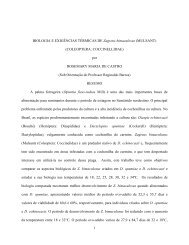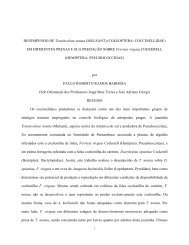Development of Spodoptera frugiperda on different hosts ... - UFRPE
Development of Spodoptera frugiperda on different hosts ... - UFRPE
Development of Spodoptera frugiperda on different hosts ... - UFRPE
You also want an ePaper? Increase the reach of your titles
YUMPU automatically turns print PDFs into web optimized ePapers that Google loves.
244 Barros et al.<br />
larva. According to Meyer et al. (2004) young cott<strong>on</strong> bolls<br />
before seed maturati<strong>on</strong> do not c<strong>on</strong>tain gossypol, as the<br />
seeds have not yet developed. Thus, FAW moths col<strong>on</strong>izing<br />
cott<strong>on</strong> fields in early stages <str<strong>on</strong>g>of</str<strong>on</strong>g> boll development will<br />
find suitable food for their larvae that survive and move to<br />
the s<str<strong>on</strong>g>of</str<strong>on</strong>g>t bolls.<br />
Although low performance is found for FAW larvae<br />
infesting cott<strong>on</strong> plants in the blooming stage, development<br />
and survival were sufficient to permit the populati<strong>on</strong> to<br />
increase after completing two immature generati<strong>on</strong>s, <strong>on</strong>ly<br />
<strong>on</strong>e <str<strong>on</strong>g>of</str<strong>on</strong>g> which occurred when bolls were abundant. It is also<br />
important to note that few bolls were available during the<br />
infestati<strong>on</strong> at Blooming 1 compared to the infestati<strong>on</strong> at<br />
Boll Stage or at Blooming 2. At the Blooming 2 stage, a sec<strong>on</strong>d<br />
immature generati<strong>on</strong> occurred during the predominance<br />
<str<strong>on</strong>g>of</str<strong>on</strong>g> s<str<strong>on</strong>g>of</str<strong>on</strong>g>t boll producti<strong>on</strong> by the plants.<br />
Our results indicate that successful c<strong>on</strong>trol <str<strong>on</strong>g>of</str<strong>on</strong>g> FAW in<br />
the Brazilian Cerrado will depend <strong>on</strong> tracking the populati<strong>on</strong>s<br />
across crop systems during and across seas<strong>on</strong>s c<strong>on</strong>sidering<br />
the species <str<strong>on</strong>g>of</str<strong>on</strong>g> plants used for double cropping and<br />
for cover crops in no-tillage planting systems. The use <str<strong>on</strong>g>of</str<strong>on</strong>g><br />
millet as a cover crop will <str<strong>on</strong>g>of</str<strong>on</strong>g>fer an excellent winter host for<br />
FAW to build populati<strong>on</strong>s when not limited by winter<br />
temperatures, from which FAW can col<strong>on</strong>ize the major<br />
summer crops such as corn, soybean, and cott<strong>on</strong> that compose<br />
the Cerrado landscape. The timing <str<strong>on</strong>g>of</str<strong>on</strong>g> early maturati<strong>on</strong><br />
<str<strong>on</strong>g>of</str<strong>on</strong>g> corn and soybean ( 90–110 days) overlaps with<br />
the most favorable stage <str<strong>on</strong>g>of</str<strong>on</strong>g> cott<strong>on</strong> (pre-maturati<strong>on</strong> boll<br />
stage) for FAW. The need for area-wide and crop-system<br />
management to deal with FAW is not a new c<strong>on</strong>cept<br />
(Sparks, 1986). Polyphagous, mobile species all impose<br />
similar needs to address management across landscapes.<br />
This has been addressed for Helicoverpa armigera Hübner<br />
in China and Australia (Wu, 2007; Herde, 2009), and<br />
recently for plant bugs in the USA (Abel et al., 2007).<br />
The slow development <str<strong>on</strong>g>of</str<strong>on</strong>g> FAW feeding <strong>on</strong>ly <strong>on</strong> cott<strong>on</strong><br />
leaves suggests that the outbreaks <str<strong>on</strong>g>of</str<strong>on</strong>g> FAW in cott<strong>on</strong> at the<br />
boll stage will result from <strong>on</strong>e to two previous generati<strong>on</strong>s<br />
within cott<strong>on</strong> fields if <strong>on</strong>ly cott<strong>on</strong> is the source host. Otherwise,<br />
the outbreak can be in advance from mass migrati<strong>on</strong><br />
<str<strong>on</strong>g>of</str<strong>on</strong>g> adults from nearby <strong>hosts</strong> during the maturati<strong>on</strong> <str<strong>on</strong>g>of</str<strong>on</strong>g> other<br />
crops and weeds that dominate the Cerrado landscape<br />
(e.g., corn, soybean, and pasture). Egg producti<strong>on</strong> by FAW<br />
was high irrespective <str<strong>on</strong>g>of</str<strong>on</strong>g> host used previously (Table 2),<br />
which helps to compensate for low survival <str<strong>on</strong>g>of</str<strong>on</strong>g> young larvae<br />
and, hence, the relatively high numbers <str<strong>on</strong>g>of</str<strong>on</strong>g> surviving larvae<br />
are able to cause significant damage to available bolls. Possible<br />
mass migrati<strong>on</strong> <str<strong>on</strong>g>of</str<strong>on</strong>g> adults seems to be an interesting<br />
hypothesis testable by tracking larval populati<strong>on</strong> in the<br />
crops and adult migrati<strong>on</strong> am<strong>on</strong>g the crops. Although<br />
corn is c<strong>on</strong>sidered the preferred host, FAW infests a large<br />
number <str<strong>on</strong>g>of</str<strong>on</strong>g> cultivated and uncultivated plants that are<br />
comm<strong>on</strong> in the Cerrado. These host plants can sustain<br />
FAW populati<strong>on</strong>s and functi<strong>on</strong> as a reservoir between seas<strong>on</strong>s.<br />
Moreover, millet used as a winter cover crop provides<br />
a highly suitable host for FAW, superior to corn based <strong>on</strong><br />
our results. Thus, FAW can find suitable developmental<br />
<strong>hosts</strong> year-round in the Cerrado if temperature does not<br />
impose developmental or survival limitati<strong>on</strong>s.<br />
Acknowledgements<br />
The authors acknowledge the support given, in the form <str<strong>on</strong>g>of</str<strong>on</strong>g><br />
research grants provided to the authors, by the agencies<br />
FACEPE (Fundação de Amparo a Ciência e Tecnologia do<br />
Estado de Pernambuco) and CNPq (C<strong>on</strong>selho Naci<strong>on</strong>al<br />
de Desenvolvimento Científico e Tecnológico), and<br />
research funds provided by FINEP (Financiadora de Estudos<br />
e Projetos).<br />
References<br />
Abdi H (2007) The B<strong>on</strong>fer<strong>on</strong>ni and S ˇ idák correcti<strong>on</strong>s for multiple<br />
comparis<strong>on</strong>s. Encyclopedia <str<strong>on</strong>g>of</str<strong>on</strong>g> Measurement and Statistics,<br />
Vol. 2 (ed. by N Salkind), pp. 540–542. Sage Publicati<strong>on</strong>s,<br />
Thousand Oaks, CA, USA.<br />
Abel CA, Snodgrass GL & Gore J (2007) A cultural method for<br />
the area-wide c<strong>on</strong>trol <str<strong>on</strong>g>of</str<strong>on</strong>g> tarnished plant bug Lygus lineolaris,in<br />
cott<strong>on</strong>. Area-Wide C<strong>on</strong>trol <str<strong>on</strong>g>of</str<strong>on</strong>g> Insect Pests from Research to<br />
Field Implementati<strong>on</strong>, Vol. 1 (ed. by MJB Vreysen, AS Robins<strong>on</strong><br />
& J Hendrichs), pp. 497–504. Springer, Dordrecht, The<br />
Netherlands.<br />
Ali A & Luttrell RG (1990) Survival <str<strong>on</strong>g>of</str<strong>on</strong>g> fall armyworm (Lepidoptera:<br />
Noctuide) immatures <strong>on</strong> cott<strong>on</strong>. Florida Entomologist<br />
73: 459–465.<br />
Ali A, Luttrell RG & Pitre HN (1990) Feeding sites and distributi<strong>on</strong><br />
<str<strong>on</strong>g>of</str<strong>on</strong>g> fall armyworm (Lepidoptera: Noctuidae) larvae <strong>on</strong> cott<strong>on</strong>.<br />
Envir<strong>on</strong>mental Entomology 19: 1060–1067.<br />
Arruda FP, Andrade AP, Silva IF, Pereira IE & Guimarães MAM<br />
(2002) Emissão ⁄ Abscisão de estruturas reprodutivas do algodoeiro<br />
herbáceo cv CNPA 7H: efeito do estresse hídrico. Revista<br />
Brasileira de Engenharia Agrícola 6: 21–27.<br />
Barros EM, Torres JB & Bueno AF (2010) Oviposição, desenvolvimento<br />
e reproduçãode<str<strong>on</strong>g>Spodoptera</str<strong>on</strong>g> <str<strong>on</strong>g>frugiperda</str<strong>on</strong>g> (J.E. Smith)<br />
(Lepidoptera: Noctuidae) em diferentes hospedeiros de importância<br />
ec<strong>on</strong>ômica. Neotropical Entomology 39 (in press).<br />
Busato GR, Grutzmacher AD, Oliveira AC, Vieira EA, Zimmer<br />
PD et al. (2004) Análise da estrutura e diversidade molecular<br />
de populações de <str<strong>on</strong>g>Spodoptera</str<strong>on</strong>g> <str<strong>on</strong>g>frugiperda</str<strong>on</strong>g> (J.E. Smith) (Lepidoptera:<br />
Noctuidae) associadas às culturas do milho e arroz no<br />
Rio Grande do Sul. Neotropical Entomology 33: 709–716.<br />
Capinera JL (2002) Handbook <str<strong>on</strong>g>of</str<strong>on</strong>g> Vegetable Pests, Vol. 1. Academic<br />
Press, San Diego, CA, USA.<br />
Cruz I (1995) A Lagarta-do-Cartucho na Cultura do Milho. Embrapa<br />
Milho e Sorgo, Sete Lagoas, MG, Brasil (Circular Técnica<br />
21).




